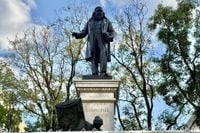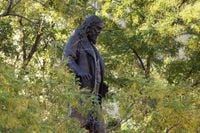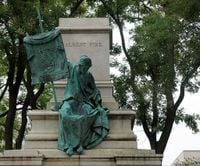On a brisk Saturday morning in late October 2025, workers quietly maneuvered heavy equipment into Judiciary Square, Washington, D.C., and set about re-erecting a monument that has, for decades, stood at the crossroads of American memory and controversy. The 27-foot bronze and marble statue of Confederate General Albert Pike—toppled and set ablaze during the nationwide protests of June 2020—was once again hoisted onto its pedestal, fenced off from the public and shadowed by the city’s police headquarters.
The return of Pike’s statue, according to reporting from UPI and WTOP News, marks the latest chapter in a saga that began over a century ago. Originally dedicated in 1901, the statue was authorized by Congress after vigorous lobbying by Freemasons, who insisted Pike be depicted in civilian attire to honor his more than 30 years as Sovereign Grand Commander of the Ancient and Accepted Rite of Scottish Freemasonry. The monument’s plaque describes Pike as an “author, poet, scholar, soldier, jurist, orator, philanthropist and philosopher.” Yet, for many, those words ring hollow in light of his service to the Confederacy and the allegations that have since shadowed his legacy.
The events of June 19, 2020—Juneteenth—are still vivid for many D.C. residents. Demonstrators, galvanized by the murder of George Floyd and the broader Black Lives Matter movement, pulled down Pike’s statue with ropes and chains, then doused it in lighter fluid and set it ablaze. The moment, broadcast live on television, was part of a national reckoning with Confederate symbols and systemic racism. According to NBC Washington, the statue sat in storage for more than five years, its fate uncertain as debates raged over how America should remember its past.
In August 2025, the National Park Service (NPS) announced that the statue would return to its original spot. The agency cited “federal responsibilities under historic preservation law as well as recent executive orders to beautify the nation’s capital and reinstate pre-existing statues.” The restoration, the NPS said, was not just about Pike, but about “restoring truth and sanity to American history”—a phrase borrowed directly from President Donald Trump’s executive order issued earlier in the year. The order instructed the Secretary of the Interior to review monuments removed since January 2020 and to take steps to reinstall those deemed historically significant.
This move, however, has been met with fierce opposition from local leaders and many residents. The D.C. Council first called for the statue’s removal back in 1992, and in 2017, Mayor Muriel Bowser struck a deal to eventually take it down—though it wasn’t removed until protesters did the job themselves. Delegate Eleanor Holmes Norton, who has introduced multiple bills in Congress to permanently remove the statue, minced no words: “The morally objectionable move is an affront to the mostly Black and Brown residents of the District of Columbia and offensive to members of the military who serve honorably.” In a statement to BERITAJA, Norton added, “Pike himself served dishonorably. He took up arms against the United States, misappropriated funds, and was yet captured and imprisoned by his own troops. He resigned in disgrace after committing a war crime and dishonoring even his own Confederate military service.”
Norton’s criticism is not new. Over the years, various D.C. officials and activists have argued that the statue’s presence in a public park, rather than a museum, implies a level of honor that is inappropriate for a figure who fought against the United States. Some resolutions have gone even further, referring to Pike as a “chief founder of the post-Civil War Ku Klux Klan”—a claim that remains hotly disputed by the Freemasons, who maintain their veneration of Pike is based solely on his contributions to their order.
For its part, the National Park Service has maintained that the restoration process was carried out in accordance with both historic preservation law and the directives of the executive branch. Photographs released by the NPS this summer showed workers painstakingly removing corrosion and layers of paint from the statue, a sign—perhaps—that the government intended to restore not just the monument’s physical form, but its place in the city’s landscape. As of Sunday, October 26, the statue stood behind a chain link fence, flanked by two John Deere cherry pickers and a sign reading, “Area closed. Historic preservation work in progress.”
Yet, the statue’s return has reignited the debate over how America should confront its history. Supporters of the reinstallation, including some federal officials, argue that removing statues amounts to erasing history. They point to Pike’s civilian achievements and his pardon by President Andrew Johnson as reasons to preserve his memory in the public square. The Freemasons, for whom Pike remains a revered figure, emphasize that the statue was never intended to honor his Confederate service, but rather his legacy as a philosopher and leader of their order.
Critics, however, see things quite differently. For many, the statue is a painful reminder of a legacy of racism and rebellion against the United States. Norton and others argue that monuments to Confederate leaders belong in museums, where they can be contextualized as artifacts of a troubled past, not celebrated as civic heroes. “A statue honoring a racist and a traitor has no place on the streets of D.C.,” Norton declared this summer, echoing the sentiments of many residents who watched the statue burn in 2020.
The debate over the Pike statue is emblematic of larger national conversations about memory, identity, and justice. In the wake of the 2020 protests, dozens of Confederate monuments were removed across the United States, and several military bases named for Confederate leaders were given new names. Yet, as the return of the Pike statue shows, the fight over how—and whether—to commemorate the Confederacy is far from settled.
For now, the statue of Albert Pike stands once again in Judiciary Square, its future as uncertain as the history it represents. Surrounded by fencing and controversy, it remains a symbol—whether of heritage or of harm—at the heart of the nation’s capital.






